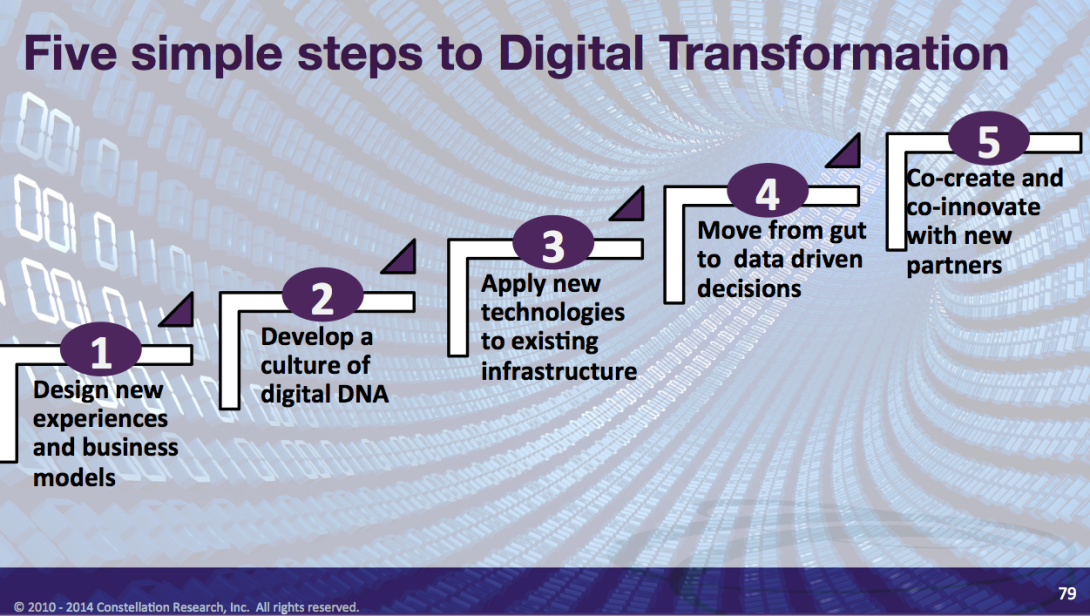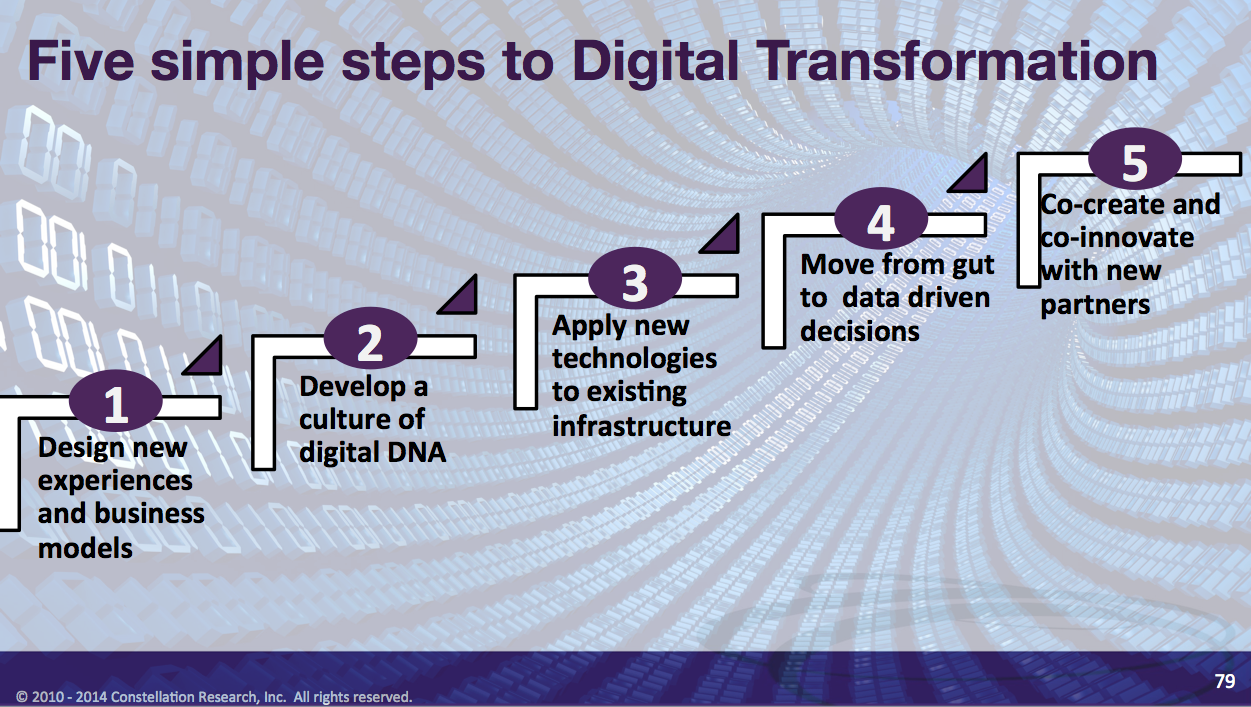
Tuesday's Tip: Five Steps To Starting Your Digital Transformation Initiative

Cut Through The Hype and Get Started
Over the past 12 months, Constellation has interviewed, researched, or assisted more than 50 market leaders and fast followers crafting a digital transformation strategy. Regardless of industry, size of company, or geography, these early adopters share five common steps to success. In each case, these steps provide the foundation to not only transforming their business models, but also reinventing their brand promise. These five steps include (see Figure 1):
- Designing new experiences and business models. Use digital as an opportunity to craft new experiences. Customers seek outcomes and experiences while organizations continue to sell products and services. This gap in expectations only exacerbates in a digital world. In fact, successful digital business models reinforce the brand promise and promote the brand mythology. The shift to a sense and respond model requires a new design point. Mass personalization at scale, big data business models, and augmented humanity provide a starting point to designing a new digital experience. Early adopters all have applied concepts in design thinking from the beginning. Over the past 18 months, Constellation has helped organizations with digital transformation workshops to set the stage or imagine how digital disruption will impact an organization's business model.
- Developing a culture of digital DNA. Success begins at the top. Digital DNA requires strong leaders who are not afraid of dips in share price, cannibalizing existing markets, and identifying new approaches. Organizations must also assess their innate ability to thrive in a digital business environment and nurture digital artisans. These skills go not only beyond the quant jocks who deliver hard science and engineering prowess, but also beyond the creative class who can co innovate and co-create on demand. Consequently, organizations are rethinking the attributes a digital business should employ and embody. Diversity in thinking means more than race or age or digital proficiency. A balance of thought. In an organizations with too many hard sciences, balance out recruiting with philosophers or anthropologists. In an organization with too many thinkers, balance out the model with teams who can execute. Using a framework for digital proficiency and a checklist on digital artisans, organizations can infuse digital DNA throughout the culture.
- Applying new technologies to existing infrastructure. Digital does not mean wholesale replacement of existing technologies. Digital does not mean just putting a mobile front end or adding a social collaboration feature to a process. The convergence of mobile, social, cloud, analytics (big data), and unified communications provide starting points. Adding sensors to old machinery provides data and context. Mobilizing mainframe data for use in analytics delivers new experiences and provides insight into new opportunities. Bringing external data to internal systems creates new patterns that provide better data for testing out new business models. Use the opportunity to rethink your technology strategy to align with the business objectives of digital transformation.
- Moving from gut to data driven decisions. Data is the heart of digital transformation. Every touch point, every click, every interaction provides a digital exhaust rich in context. The goal is to move from right time information overload, to real-time contextual relevancy. Organizations need relevancy delivered in real time. From asking the right questions to anticipating future beahvior, the goal is to move from data to decisions. Every bit of data flows into upstream and downstream information aligned with business processes. These information flows then provide the foundation to surface patterns that provide insight. That business insight then enables people to make fact based decisions. Serving up this next best action is the foundation of building data driven decisions.
- Co-creating and co-innovating with new partners. No company can succeed on their own. In digital transformation, an ecosystem of co-creation and co-innovation awaits. Organizations should participate in industry consortiums and also create their own ecosystems aligned around the organization's self-interest. In many scenarios, an ecosystem does not exist but market leading and fast follower vendors, suppliers, and customers will join with strong leadership.
Figure 1. The Five Steps To Digital Transformation Success
The Bottom Line: Prepare for the Rise of Chief Digital Officers Or Leaders Infused With Digital DNA
The existing leadership structure in most organizations is ill-equipped to drive the change required for dominating digital disruption. Consequently, the emergence of the chief digital officer (CDO) is essential for the new age of digital business. Though the current debate often centers on whether the CIO or CMO will win out or whether chief digital officers may arise from an expanded role for the CIO, we see these arguments as short-sighted. As with any other massive transformation, the skill sets required for digital will be infused throughout the executive ranks and the organization's DNA. The pathway forward will involve a multidisciplinary approach. However, the skills behind digital business transformation will require chief digital officers or those tasked with digital to understand how to:
- Translate analog businesses into digital businesses. The effort will require more than adopting the five pillars of digital convergence, but a rethink of the core business model. The new model moves from promoting products and services to keeping promises and meeting outcomes.
- Manage a world of trust and radical transparency. Success will require more than fluffy statements about open leadership. The power belongs in building relationships in the personal and corporate networks. Leaders must expect business to move from real time to right time. Context by location, time, role, relationship, sentiment and even intent will provide a differentiator.
- Develop an authentic business brand. An organization must start by asking itself what the company would be like if it were a person. Customers, employees, partners and suppliers expect an organization to live up to a brand promise. That promise requires authenticity in a digital world.
- Disrupt business models with digital technologies. Keep in mind, technologies will come and go. Disruptive technologies on their own will not address regulatory requirements, optimize costs, drive revenue, differentiate markets or support the brand. The goal is to identify the technologies that will disrupt the business model to allow for transformational change.
- Work with five generations of digital proficiency. Focus in on how to enable the different generations for digital proficiency. Keep in mind, digital business brings its own culture for how you work, where you work, when you work, what you work on and why you work. These are the key questions in the shift from a people and cultural perspective.
While we see many media, entertainment and technology organizations rapidly moving to develop a CDO role, other industries will eventually embrace a central champion who ensures the digital business principles and policies are in concert with an organization’s overall strategy. Today's CTO's are also poised to be good CDO's.
In any case, the rise of the chief digital officer is here. Constellation research shows that digitally transofmred organizations differentiate themselves with higher margins, greater market share, increased brand relevancy and massive scale.
Join us October 29th to 31st for Constellation's Connected Enterprise, an immersive innovation summit for senior business leaders using digital technologies to transform their organizations. These leaders convene to discover, share, and inspire each other on how digital business can realize brand promises, transform business models, increase revenues, reduce costs, and improve compliance.
The 3-day executive retreat will include mind expanding keynotes from visionaries and futurists, interactive best practices panels, deep 1:1 20 minute interviews with market makers, rapid fire high-energy new technology demos, The Constellation SuperNova Awards event, a golf outing, and an immersive networking event.
Your POV.
How are you addressing digital transformation? Is your organization ready for digital disruption? Let us know how you are getting there and what first steps have worked. Add your comments to the blog or reach me via email: R (at) ConstellationR (dot) com or R (at) SoftwareInsider (dot) org.
- Developing your digital business strategy
- Identifying areas for business model disruption
- Connecting with other market leaders and fast followers
- Sharing best practices
- Vendor selection
- Providing contract negotiations and software licensing support
- Implementation partner selection
- Monday’s Musings: What Organizations Want From Mobile
- Research Summary: Economic Trends Exacerbate Digital Business Disruption And Digital Transformation (The Futurist Framework Part 3)
- Research Summary: Five Societal Shifts Showcase The Digital Divide Ahead (The Futurist Framework Part 2)
- Research Summary: Sneak Peaks From Constellation’s Futurist Framework And 2014 Outlook On Digital Disruption
- Research Report: Digital ARTISANs – The Seven Building Blocks Behind Building A Digital Business DNA
- Research Summary: Five Societal Shifts Showcase The Digital Divide Ahead (The Futurist Framework Part 2)
- Research Summary: Next Generation CIOs Aspire To Focus More On Innovation And The Chief Digital Officer Role
- Trends: [VIDEO] The Digital Business Disruption Ahead Preview – NASSCOM India Leadership Forum (#NASSCOM_ILF)
- News Analysis: New #IBMWatson Business Group Heralds The Commercialization Of Cognitive Computing. Ready For Augmented Humanity?
- Harvard Business Review: What a Big Data Business Model Looks Like
- Monday’s Musings: How The Five Consumer Tech Macro Pillars Influence Enterprise Software Innovation
- Tuesday’s Tip: Understand The Five Generation Of Digital Workers And Customers
- Monday’s Musings: The Chief Digital Officer In The Age Of Digital Business
- Slide Share: The CMO vs CIO – Pathways To Collaboration
- Event Report: CRM Evolution 2013 – Seven Trends In The Return To Digital Business And Customer Centricity
- News Analysis: Sitecore Acquires Commerce Server In Quest Towards Customer Experience Management
- News Analysis: Salesforce 1 Signals Support For Digital Business at #DF13
- Research Summary And Speaker Notes: The Identity Manifesto – Why Identity Is At The Heart of Digital Business
Reprints
Reprints can be purchased through Constellation Research, Inc. To request official reprints in PDF format, please contact Sales .
Disclosure
Although we work closely with many mega software vendors, we want you to trust us. For the full disclosure policy,stay tuned for the full client list on the Constellation Research website.
* Not responsible for any factual errors or omissions. However, happy to correct any errors upon email receipt.
Copyright © 2001 -2014 R Wang and Insider Associates, LLC All rights reserved.
Contact the Sales team to purchase this report on a a la carte basis or join the Constellation Customer Experience
 R "Ray" Wang
R "Ray" Wang R "Ray" Wang
R "Ray" Wang